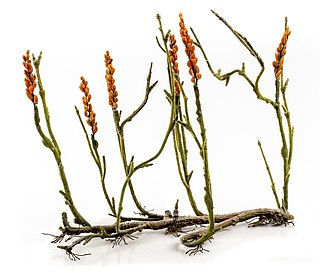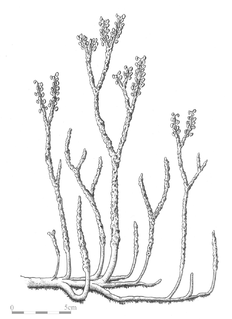
The zosterophylls are a group of extinct land plants that first appeared in the Silurian period. The taxon was first established by Banks in 1968 as the subdivision Zosterophyllophytina; they have since also been treated as the division Zosterophyllophyta or Zosterophyta and the class or plesion Zosterophyllopsida or Zosteropsida. They were among the first vascular plants in the fossil record, and had a world-wide distribution. They were probably stem-group lycophytes, forming a sister group to the ancestors of the living lycophytes. By the late Silurian a diverse assemblage of species existed, examples of which have been found fossilised in what is now Bathurst Island in Arctic Canada.

Zosterophyllum was a genus of Silurian-Devonian vascular land plants with naked branching axes on which usually kidney-shaped sporangia were arranged in lateral positions. It is the type genus for the group known as zosterophylls, thought to be part of the lineage from which modern lycophytes evolved. More than 20 species have been described.

Sawdonia is an extinct genus of early vascular plants, known from the Upper Silurian to the Lower Carboniferous. Sawdonia is best recognized by the large number of spikes (enations) covering the plant. These are vascular plants that do not have vascular systems in their enations. The first species of this genus was described in 1859 by Sir J. William Dawson and, was originally attributed to the genus Psilophyton. He named this plant Psilophyton princeps. In 1971 Francis Hueber proposed a new genus for this species due to its "Divergent technical characters from the generic description for Psilophyton." The holotype used for description is Dawson Collection Number 48, pro parte, Museum Specimen Number 3243. Sir J. William Dawson Collection, Peter Redpath Museum, McGill University, Montreal, Quebec, Canada.

Yunia is a genus of extinct vascular plants from the Early Devonian. It was first described from the Posongchong Formation of Yunnan, China. The leafless plant consisted of spiny stems, some 2 to 5 cm wide, which branched dichotomously at wide angles in a cruciate arrangement. Each stem contained vascular tissue with one or two strands of protoxylem. The spore-forming organs (sporangia) were elongated and borne on short stalks. The spores had a relatively smooth sculptural pattern and were trilete.
Hicklingia is a genus of extinct plants of the Middle Devonian. Compressed specimens were first described in 1923 from the Old Red Sandstone of Scotland. Initially the genus was placed in the "rhyniophytes", but this group is defined as having terminal sporangia, and later work showed that the sporangia of Hicklingia were lateral rather than strictly terminal, so that it is now regarded as having affinities with the zosterophylls.
Huia is a genus of extinct vascular plants of the Early Devonian. The genus was first described in 1985 based on fossil specimens from the Posongchong Formation, Wenshan district, Yunnan, China.
Gumuia is a genus of extinct vascular plants of the Early Devonian. The genus was first described in 1989 based on fossil specimens from the Posongchong Formation, Wenshan district, Yunnan, China.

Adoketophyton is a genus of extinct vascular plants of the Early Devonian. The plant was first described in 1977 based on fossil specimens from the Posongchong Formation, Wenshan district, Yunnan, China. These were originally named Zosterophyllum subverticillatum; later the species was transferred to a new genus as Adoketophyton subverticillatum. One cladistic analysis suggested that it is a lycophyte, related to the zosterophylls. Other researchers regard its placement within the vascular plants as uncertain.
Discalis is a genus of extinct vascular plants of the Early Devonian. The name is derived from the Greek δίσκος, referring to the disc-shaped sporangia. The genus was first described by Hao in 1989 based on fossil specimens from the Posongchong Formation, Wenshan district, Yunnan, China.
Distichophytum is a genus of extinct vascular plants of the Late Silurian (Ludfordian) to Early Devonian (Emsian), around 426 to 393 million years ago. The genus has a tangled taxonomic history, also being known as Bucheria and Rebuchia.

Nothia was a genus of Early Devonian vascular plants whose fossils were found in the Rhynie chert in Scotland. It had branching horizontal underground stems (rhizomes) and leafless aerial stems (axes) bearing lateral and terminal spore-forming organs (sporangia). Its aerial stems were covered with small 'bumps' (emergences), each bearing a stoma. It is one of the best described early land plants. Its classification remains uncertain, although it has been treated as a zosterophyll. There is one species, N. aphylla.
Danziella is a genus of extinct vascular plants of the Early Devonian. Fossils found in the Artois region of northern France were first described as Zosterophyllum artesianum, but a later review by Edwards showed that they did not fit the circumscription of that genus.
Aberlemnia is a genus of extinct vascular plants of the Early Devonian, which consisted of leafless stems with terminal spore-forming organs (sporangia). Fossils found in Scotland were initially described as Cooksonia caledonica. A later review, which included new and more complete fossils from Brazil, showed that the specimens did not fit the circumscription of the genus Cooksonia; accordingly a new genus Aberlemnia was proposed.
Trichopherophyton is a genus of extinct vascular plants of the Early Devonian. Fossils were found in the Rhynie chert, Scotland. The remains are very fragmentary, but the plant appears to be related to the zosterophylls.
Wenshania is a genus of extinct vascular plants found in the Posongchong Formation, Yunnan, China, which is of Early Devonian age. Plants consisted of leafless stems with simple dichotomous branching, and bore spore-forming organs or sporangia all around the sides of stems. Wenshania is part of the broadly defined group of zosterophylls.
Bracteophyton is a genus of extinct vascular plants of the Early Devonian comprising a single species, Bracteophyton variatum. Fossils were first found in the Xujiachong Formation of eastern Yunnan, China.
Halleophyton is a genus of extinct vascular plants of the Early Devonian. Fossils were first found in the Posongchong Formation of eastern Yunnan, China. The plant had leafy aerial stems. The leaf bases completely covered the stems forming rhomboidal to hexagonal patterns, except where spore-forming organs or sporangia were present where the leaves thinned out somewhat. The tapered undivided leaves curved inwards and appear to have had a central vein. The sporangia were mixed with leaves and were more-or-less circular in outline, consisting of two valves which split to release the spores. Halleophyton has similarities with Drepanophycus, but a lack of detailed knowledge of some features of that genus persuaded Li and Edwards to create a new genus for their specimens. Although considered to be related to the lycophytes, the exact placement of the genus was left open by its authors. Hao and Xue in 2013 listed the genus as a lycopsid.

Macivera is a genus of extinct vascular plants. Fossils were found in sediments in Bathust Island, Nunavut, Canada, from the upper Silurian. The leafless stems (axes) branched dichotomously and were relatively thin, being between 0.7 and 1.0 mm wide. Spore-forming organs or sporangia, which were elliptical, being longer than wide, were borne on the end regions of stems. Macivera is considered to be a zosterophyll.
Gosslingiales is an order of extinct zosterophylls. The zosterophylls were among the first vascular plants in the fossil record, and share an ancestor with the living lycophytes. The group has been divided up in various ways. Hao and Xue in 2013 used the presence or absence of terminal sporangia as a major dividing feature. The order Zosterophyllales was used for species with terminal as well as lateral sporangia, which were considered to have determinate growth, with their sporangia generally being arranged in spikes. The paraphyletic order Gosslingiales was used for species without terminal sporangia, which were considered to have indeterminate growth, with fertile branches generally circinate. Species assignable to the Gosslingiales made up about 9% of all confirmed species in the Early Devonian flora.
Ramoferis is a genus of extinct vascular plants of the Pragian stage of the Early Devonian, around 411 to 408 million years ago. It is considered to be a zosterophyll, one of a group of plants that were related to the ancestors of the modern lycopsids. Fossils were found in the Posongchong Formation in Guangnan County, Yunnan, in southwestern China, where they occur as compressions.






